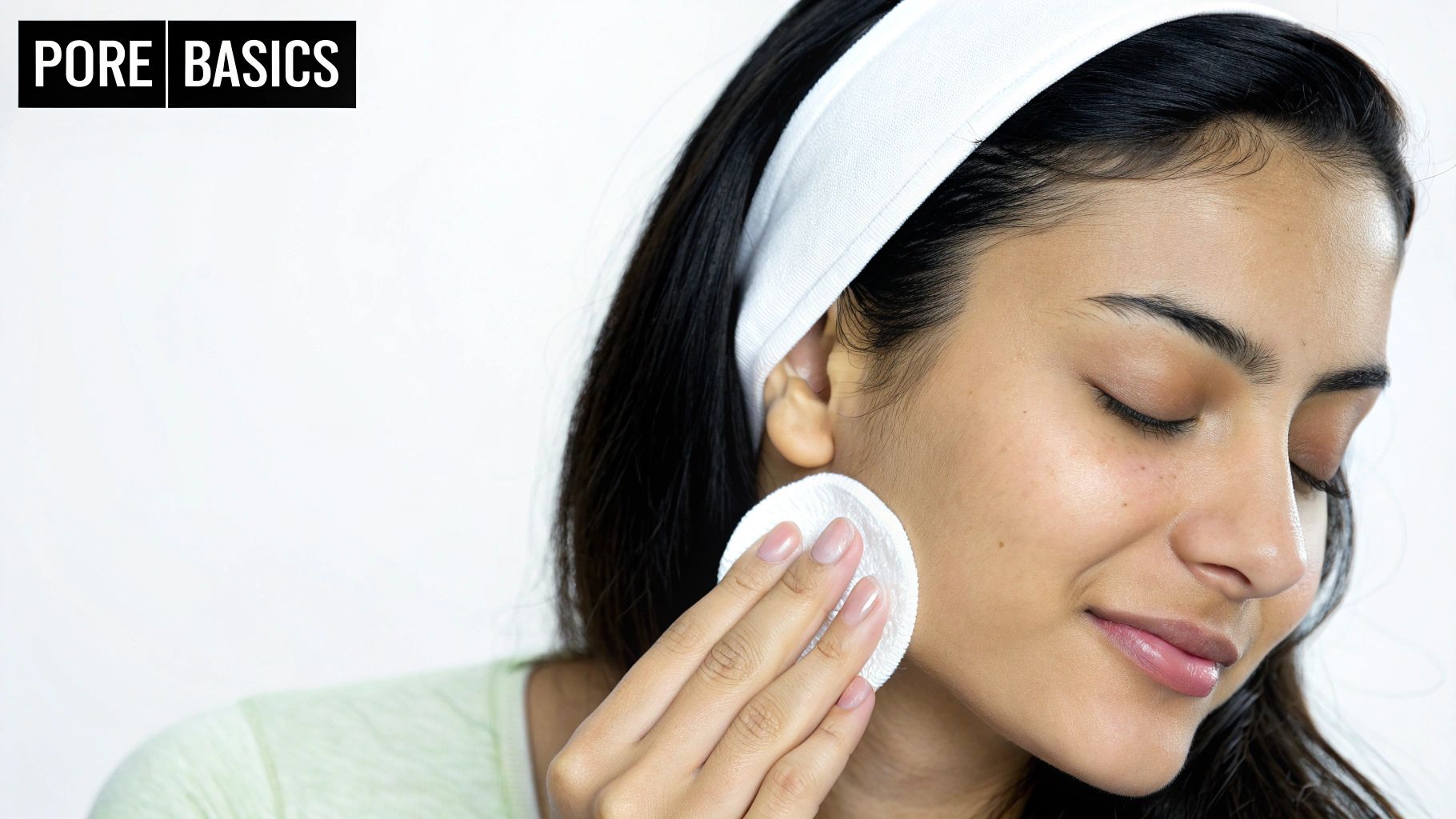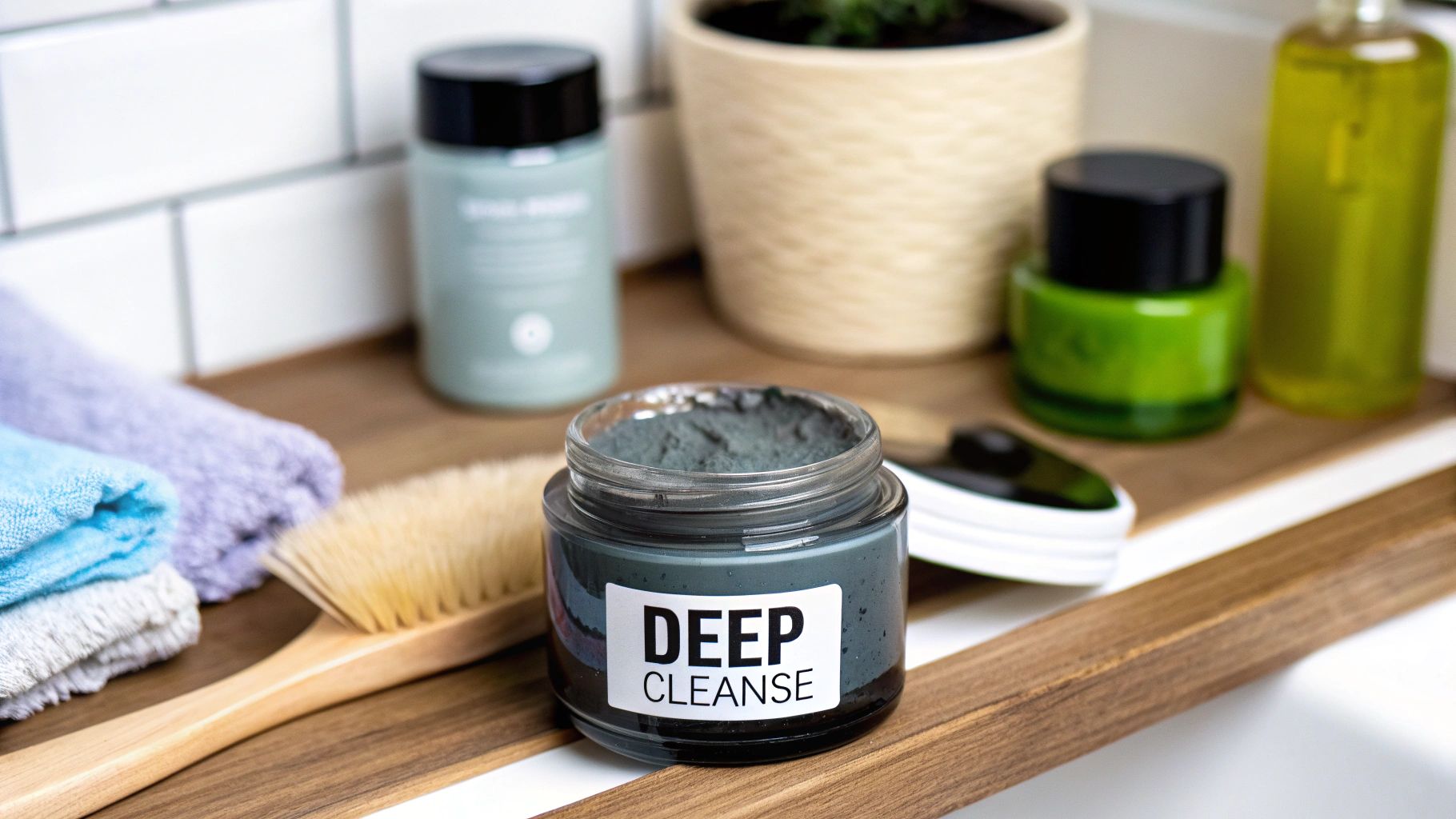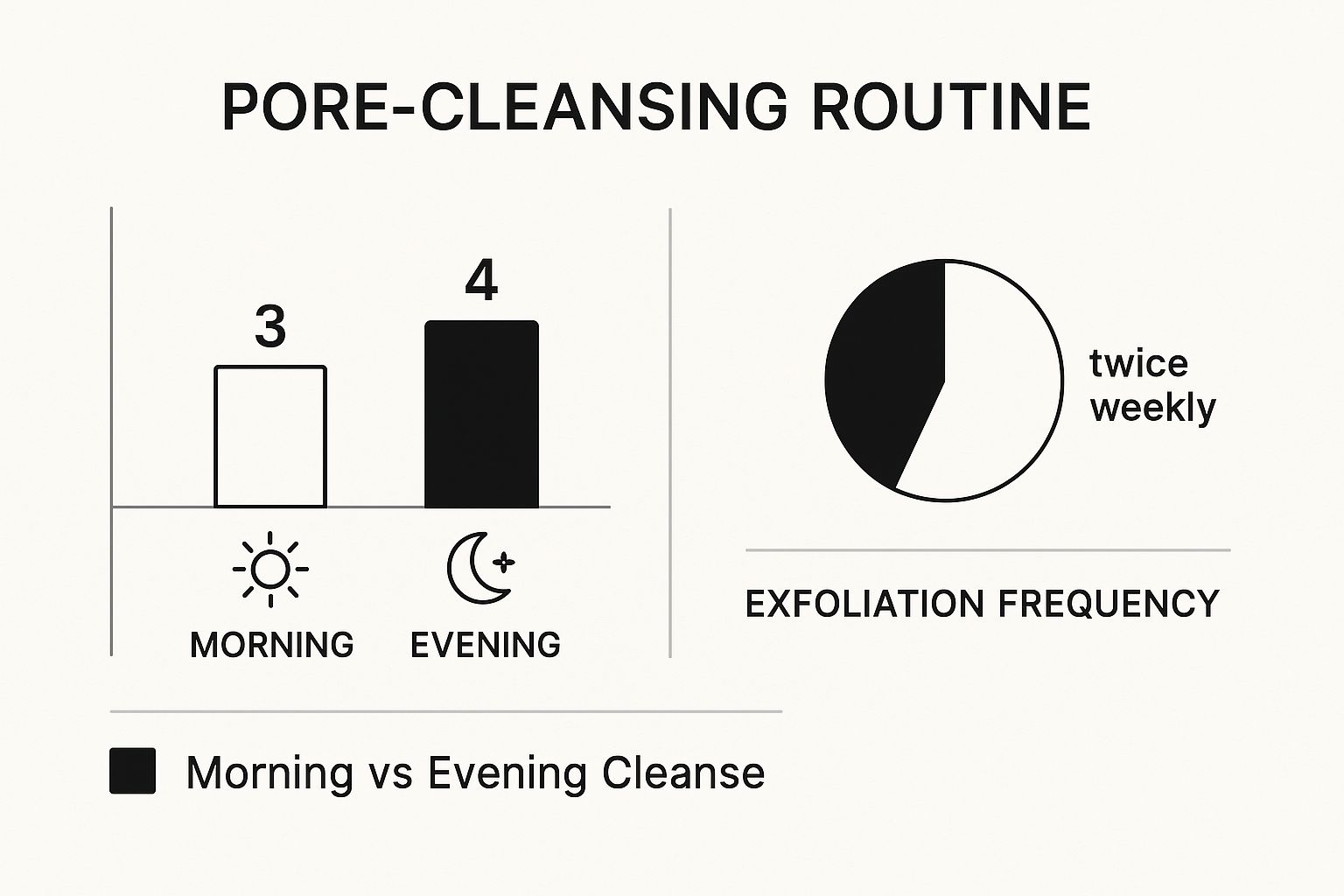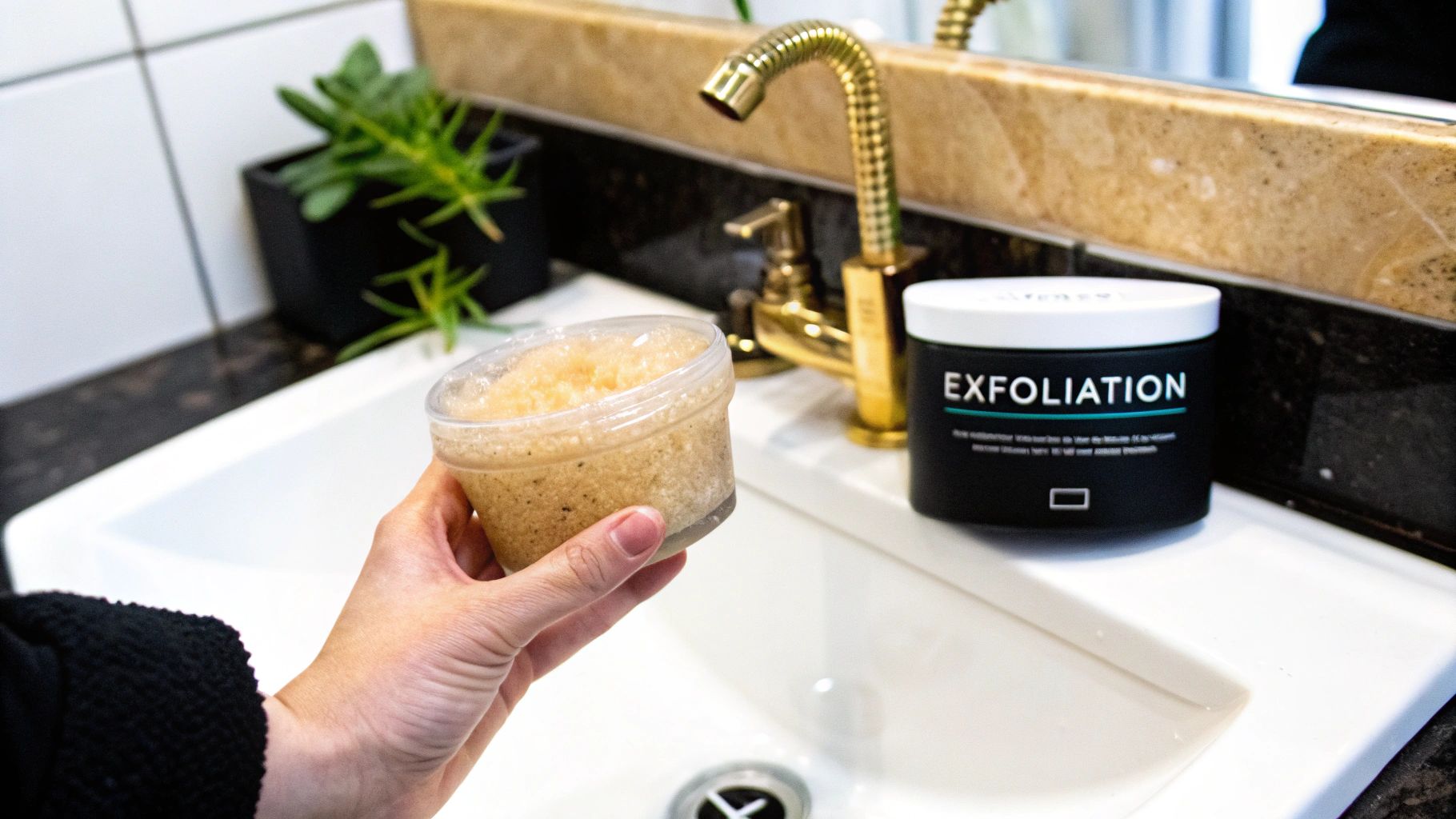Jan Elvis
30.09.2025

Jan Elvis
30.09.2025
Before we dive into how to clean out your pores, let's get a clear picture of what's actually going on in there. It’s not as complicated as you might think. Essentially, your pores are getting backed up with a mix of excess oil (sebum), dead skin cells, and whatever grime you’ve picked up during the day.
It's less like a door that needs to be forced open and more like a tiny funnel that’s slowly getting plugged up.

First, let's bust a common myth: pores don't open and close like little doors. They're just the openings to your hair follicles and oil glands, and their size is pretty much set by your genetics. When they look bigger, it's usually because they're stretched out by all that gunk inside.
This buildup is a sticky combination of your skin’s natural oil and dead skin cells that didn't get the memo to leave. This mixture forms a plug. When that plug gets exposed to air, it oxidizes and turns dark, creating the all-too-familiar blackhead. Unsurprisingly, this whole process is a major player in acne development. Learning more about managing troublesome acne symptoms can give you a better handle on the situation.
It’s not just one thing that causes clogged pores; it's a combination of factors, both internal and external. Figuring out what your personal triggers are is half the battle.
Here are the usual suspects:
And yes, you can often thank your parents. Genetics play a huge role not only in your pore size but also in how oily your skin is and how fast your skin cells turn over. If they dealt with oily skin, chances are you will too.
Don't forget about your surroundings. High humidity can make you sweatier and oilier, and daily exposure to pollution adds yet another layer of dirt that can find its way into your pores.
Believe it or not, your background can have a say in your pore situation. Research has found that pore characteristics can be quite different across various ethnicities and age groups.
For example, one fascinating study showed that younger Brazilian participants had a high pore density of about 91.3 pores/cm², which decreased as they got older. Meanwhile, Chinese individuals had a much lower and more consistent density of around 20-24 pores/cm², regardless of age.
This just goes to show that a one-size-fits-all approach to skincare rarely works. Knowing what's really causing your pores to clog is the first step in finding a routine that will actually get you results.

If you’re serious about getting—and keeping—your pores clean, the real secret isn't some miracle one-off treatment. It's all about what you do every single day. Think of it this way: a consistent routine is your front-line defense against the daily onslaught of oil, dead skin, and dirt that inevitably leads to clogged pores.
This isn’t about a massive spring cleaning for your face. It's daily maintenance. You wouldn't let your kitchen get filthy before wiping down the counters, right? The same logic applies to your skin. A simple, consistent habit keeps pores clear before they become a bigger problem.
For anyone struggling with congested skin, the double-cleansing method is a total game-changer. This two-step process is the best way I’ve found to guarantee you’re getting everything off your skin at night, leaving nothing behind to settle into your pores. It's non-negotiable if you wear sunscreen (which you should be!) or live in a city with a lot of pollution.
Here’s the breakdown:
Start With an Oil-Based Cleanser: I know, putting more oil on your skin sounds completely backward, especially if you’re already oily. But trust me on this: oil dissolves oil. A cleansing oil or balm will literally melt away all the stubborn, oil-based gunk like sunscreen, makeup, and your skin's own excess sebum. You just massage it onto dry skin, add a splash of water to get it milky, and rinse it all away.
Follow With a Water-Based Cleanser: This is where you actually wash your skin. The second cleanse gets rid of any leftover residue and preps your skin for the rest of your routine. The trick is picking the right one for your skin type. If you're oily or prone to breakouts, a cleanser with salicylic acid is brilliant because it exfoliates inside the pore. For those with drier or more sensitive skin, stick with a gentle, hydrating formula that won’t strip your skin.
This one-two punch leaves your face perfectly clean and ready for the next steps.
The most effective routine is one you can stick with. Consistency is far more important than complexity. Building a solid yet simple habit is the foundation for clear, healthy-looking skin.
This is probably the biggest mistake I see people make when they're trying to deal with clogged pores and oily skin. They skip the moisturizer, thinking, "Why add more moisture to skin that's already greasy?" It seems logical, but it almost always makes things worse.
When your skin gets dehydrated, its self-defense mechanism kicks in: it pumps out even more oil to try and compensate. This puts your oil glands into overdrive, creating a frustrating cycle of more oil, more shine, and—you guessed it—more clogged pores. A good moisturizer is critical for keeping that oil production in check. We get into the nitty-gritty of building a full routine in our guide to a proper skincare routine for men.
To hydrate your skin without risking more congestion, always look for moisturizers labeled "non-comedogenic." That's just the industry term for "formulated not to clog pores." Ingredients like hyaluronic acid and glycerin are fantastic because they pull moisture into the skin without feeling heavy or greasy. It’s a simple step that keeps your skin balanced and much less likely to clog up.
Your daily routine is the bedrock of clear pores, but it's the weekly treatments that really make a dramatic difference. If you're wondering how to truly deep-clean your pores, it's time to bring in the heavy hitters. These techniques go beyond a simple surface wash to dissolve stubborn gunk and visibly refine your skin's texture.
This little visual breaks down a solid morning versus evening routine and shows where those more intensive steps fit in.

As you can see, morning is all about protection. The evening is where the real deep cleaning happens, with exfoliation strategically used just a couple of times a week to prevent overdoing it.
Exfoliation has been around forever, but today's chemical exfoliants are one of the smartest and safest ways to get rid of the gunk that clogs pores. Forget those gritty, harsh scrubs of the past. These products work much more elegantly by dissolving the bonds holding dead skin cells together.
When we talk about chemical exfoliants for pores, we're really focused on two main types:
Deciding between a physical scrub and a chemical exfoliant can feel tricky, but it really comes down to your skin's needs and tolerance. Chemical exfoliants generally offer a more controlled and even exfoliation, while physical scrubs can be satisfying but risk creating micro-tears if you're not careful.
Here's a quick comparison to help you figure out what might work best for you.
| Exfoliant Type | Best For | How It Works | Frequency |
|---|---|---|---|
| Chemical (AHA/BHA) | Oily, acne-prone, mature, or sensitive skin. | Dissolves the "glue" between dead skin cells. | 2-3 times per week. |
| Physical (Scrubs/Brushes) | Normal or combination skin without active breakouts. | Manually sloughs off dead skin cells with friction. | 1-2 times per week. |
Ultimately, whether you choose a gentle scrub or a well-formulated chemical exfoliant, consistency and listening to your skin are key.
So, how do you choose? If your main goal is clearing out clogged pores and kicking blackheads to the curb, a BHA is your best bet. Look for a 2% salicylic acid serum or toner to start. If you’re more focused on general dullness and rough texture, an AHA product will likely give you the results you want.
When introducing any chemical exfoliant, go slow. Seriously. Start with just twice a week at night, after you cleanse and before you moisturize. This lets your skin build up a tolerance and helps you sidestep any potential irritation. Watch how your skin reacts, and you can adjust from there.
Getting the order right is also a huge part of making sure these products can do their job properly. If you're not sure where an acid fits into your routine, our complete guide on the proper https://dontlooktrash.com/blogs/main-character/skin-care-order-of-application lays it all out.
I like to think of a good clay mask as a super-magnet for all the junk hiding in your pores. Clays like bentonite and kaolin are naturally brilliant at drawing out impurities. They literally pull excess oil, dirt, and other debris to the surface and away from your skin.
Adding a clay mask into your routine once a week is one of the best ways to hit the reset button and maintain clear pores.
Sometimes, though, you run into pores that are so stubbornly clogged that nothing you do at home seems to work. When that happens, calling in a professional is your best move. A Blackhead Extraction Facial is one of the most direct ways to handle deep congestion. A trained esthetician uses specialized tools and techniques to safely clear everything out without damaging your skin, which is a real risk when you try to perform extractions yourself.

Figuring out how to get your pores clean is a huge win, but keeping them that way is a whole different ballgame. The real trick is learning how to play defense against everything the world throws at your face. Think about it—your skin is in a constant battle with UV rays, city smog, and a dozen other environmental stressors.
The sun, in particular, is a major pore saboteur. Daily sun exposure, even the incidental kind you get walking to your car, steadily chips away at your skin's collagen. This is the protein that acts like scaffolding, keeping your skin firm and pores tight. When that structure weakens, pores start to sag and look stretched out, no matter how clean they actually are.
This makes a good broad-spectrum sunscreen the single most important tool in your arsenal for long-term pore care. It's not just about avoiding a sunburn; it's about preserving your skin's underlying structure so your pores stay refined.
Beyond just slapping on some SPF, you can build a full-on defense system for your skin. Pollution, for example, is a huge source of free radicals—those nasty unstable molecules that trigger oxidative stress and inflammation. That inflammation can, in turn, kick your oil glands into overdrive and clog everything up again.
Here’s how you can build a stronger shield for your skin:
Protecting your skin is an all-day, all-night job. Things like temperature and humidity also mess with how your pores look. By building a strong, resilient skin barrier, you're helping your face better adapt to whatever the weather throws at it.
Don't just take my word for it. Research has shown a direct link between the environment and our pores. An AI-powered study found that conditions like low temperature, low humidity, and high sun exposure were all tied to worsened pore conditions. It's fascinating to see just how much our surroundings dictate what's happening on our skin.
Protecting your skin doesn't mean you need a 12-step routine. It's about being smart and strategic with a few products that do the heavy lifting.
Adding antioxidants and barrier-supporting ingredients to your daily routine is a brilliant move. It supercharges all your other pore-clearing efforts, making them way more effective over time. If you're looking for products with powerful but gentle ingredients, exploring a lineup of natural skin care products for men is a great place to start.
Ultimately, the goal is to build a healthy, resilient complexion that can fend for itself, keeping your pores looking clear and refined for the long haul.
We’ve all been there—staring in the mirror, desperate for clear skin, ready to try anything. But in that rush, it’s all too easy to do things that actually make clogged pores worse. Knowing how to really clean your pores is less about aggressive tactics and more about avoiding the wrong moves entirely.
So many well-meaning habits can backfire, leaving you with irritation, more oil, and sometimes even lasting damage. Let's talk about the most common traps people fall into.
It’s so tempting to just squeeze that blackhead, right? You think you're getting a quick fix, but it's one of the worst things you can do for your skin. Applying all that uneven pressure rarely gets everything out cleanly.
Instead, you're more likely to push bacteria and oil deeper into the pore. Suddenly, that minor clog becomes an angry, inflamed pimple. This is also how you end up with stubborn acne scars and those dark spots known as post-inflammatory hyperpigmentation.
And what about those oddly satisfying pore strips? While they seem effective, they’re often way too harsh. They rip off not just the top of the blackhead but also the delicate surface layer of your skin and fine vellus hairs. This can cause redness, broken capillaries, and, over time, can even stretch out your pores, making them look bigger.
A far better approach is to dissolve the clog from the inside out. A gentle BHA exfoliant, like salicylic acid, does this beautifully without all the collateral damage.
Once you learn that exfoliation is key to clearing pores, the pendulum can swing too far in the other direction. It's a classic mistake: thinking more is better. Using gritty scrubs every day or slathering on chemical exfoliants too often is a fast track to stripping your skin's natural moisture barrier.
Think of this barrier as your skin's personal bodyguard. When it gets compromised, your skin becomes dehydrated, red, and hypersensitive. And what does dehydrated skin do? It panics and produces even more oil to compensate, kicking off a vicious cycle that just leads to—you guessed it—more clogged pores.
Key Takeaway: Think of skincare as a marathon, not a sprint. Gentle consistency will always win out over aggressive, sporadic treatments. Instead of punishing your skin for having clogged pores, focus on creating a balanced routine that prevents them from forming in the first place. That means learning to listen to your skin and knowing when to pull back on exfoliants if you see any signs of tightness or irritation.
Even when you think you've got a solid routine down, questions always come up. It's totally normal. Let's tackle some of the most common things people wonder about when it comes to getting their pores clean, so you can feel confident you're doing it right.
Here are some straight-up answers to the questions I hear all the time.
Okay, let's get this one out of the way first: no, you can't permanently shrink your pores. Your pore size is pretty much set by your genetics. Thanks, Mom and Dad.
But—and this is a big but—you can absolutely make them look smaller. Pores get stretched out and look bigger when they're filled with a mix of oil, dead skin, and whatever else the day throws at you. When you get all that gunk out and keep them clear, they tighten back up to their original size and become way less noticeable.
The goal isn't to magically change your pore size, but to minimize how visible they are. A solid, consistent routine with exfoliants and collagen-boosters like retinoids is your best bet for achieving that smooth, refined look.
Skincare is a marathon, not a sprint. While your face will probably feel cleaner right away, seeing real change in your pores takes some time and consistency.
You'll likely start to see a real reduction in blackheads and congestion within 4 to 6 weeks. That's about how long it takes for your skin to go through a full cell turnover cycle, where fresh new cells make their way to the surface. It’s a natural process, and you have to work with it.
If you’re aiming for a significant change in your skin's texture and how visible your pores are overall, give it at least 3 months. Lasting results come from sticking with it day in and day out, not from a one-time fix.
This is a huge question, and most dermatologists I know are all on the same page: avoid the at-home pore vacuums and those sharp metal extraction tools. Seriously. The risk of doing more harm than good is just too high.
These gadgets can be really aggressive. Here’s why you should probably skip them:
A much safer—and ultimately more effective—approach is to use chemical exfoliants like salicylic acid. These ingredients work from the inside out, dissolving the gunk in your pores over time without all the physical trauma.
At Main Character, we're all about building a simple, effective skincare routine that helps you take charge of your life. Our products are made with high-quality ingredients designed to help you look and feel like the best version of yourself. Ready to build your own routine and get that confidence back? Get started at https://www.dontlooktrash.com.